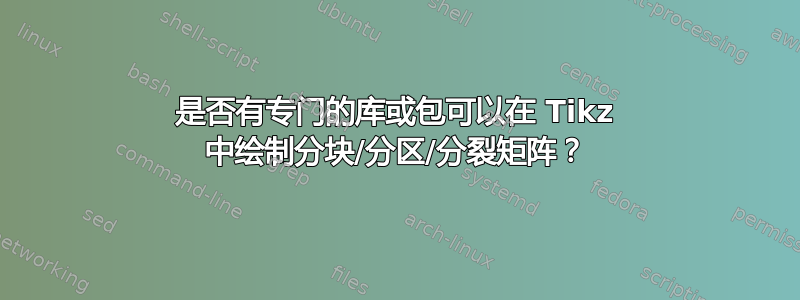
我需要编写矩阵分裂和因式分解运算(用于我的线性代数课程)。直接使用 Latex 很难完成这些操作。
我可以使用 Visio 轻松绘制这些,但我现在更喜欢使用 Tikz,因为我使用 Latex 来绘制报告。
我想展示一个我通常需要的小例子,以及一个粗略的 tikz 实现来说明我需要什么,询问是否存在一个库或者通用方法来执行此 Tikz。
这是我想要排版的典型示例:

这是 tikz 绘图的结果

以下是代码
\documentclass{article}
\usepackage{tikz}
\begin{document}
\[
A=L+D+U
\]
where
\begin{tikzpicture}
\def\x{0}
\def\y{0}
\def\L{2}
\def\s{.25}
\def\z{.35}
\draw [very thin,fill=lightgray] (\x,\y) rectangle (\x+\L,\y+\L);
\node at (\x+\L+\s,\y+\L/2) {$=$};
\node[font=\Large] at (\x+0.5*\L,\y-\z) {$A$};
\pgfmathsetmacro\x{\x+\L+2*\s}
\draw [very thin] (\x,\y) rectangle (\x+\L,\y+\L);
\draw [fill=lightgray] (\x,\y)--(\x+.9*\L,\y)--(\x,\y+.9*\L);
\node[font=\Large] at (\x+0.65*\L,\y+0.65*\L) {$0$};
\node[font=\Large] at (\x+0.5*\L,\y-\z) {$L$};
\node at (\x+\L+\s,\y+\L/2) {$+$};
\pgfmathsetmacro\x{\x+\L+2*\s}
\draw [very thin] (\x,\y) rectangle (\x+\L,\y+\L);
\draw [fill=lightgray] (\x+0.9*\L,\y)--(\x+\L,\y)--(\x+\L,\y+0.1*\L)--(\x+0.1*\L,\y+\L)--(\x,\y+\L)--(\x,\y+0.9*\L)--(\x+0.9*\L,\y);
\node[font=\Large] at (\x+0.25*\L,\y+0.25*\L) {$0$};
\node[font=\Large] at (\x+0.75*\L,\y+0.75*\L) {$0$};
\node[font=\Large] at (\x+0.5*\L,\y-\z) {$D$};
\node at (\x+\L+\s,\y+\L/2) {$+$};
\pgfmathsetmacro\x{\x+\L+2*\s}
\draw [very thin] (\x,\y) rectangle (\x+\L,\y+\L);
\draw [fill=lightgray] (\x+\L,\y+0.1)--(\x+\L,\y+\L)--(\x+0.1,\y+\L);
\node[font=\Large] at (\x+0.35*\L,\y+0.35*\L) {$0$};
\node[font=\Large] at (\x+0.5*\L,\y-\z) {$U$};
\end{tikzpicture}
\end{document}
矩阵本身可以是如图所示的矩形,不需要花哨的括号等。这个想法只是为了突出矩阵的结构(对角线、上、下、带状等...)
更新于 2013 年 7 月 23 日 晚上 9:40
有没有办法让尺寸在align环境中保持不变?
晚上10:40更新 感谢 Qrrbrbirlbel 的回复。保持尺寸不变的正确方法是
{\tikzset{set ALDU=small}
\begin{align*}
A &= L + D + U \\
\ALDU{A} &= \ALDU{L} + \ALDU{D} + \ALDU{U}
\end{align*}
}

Latex 不是很棒吗?尝试在 Microsoft Word 中执行此操作 :)
答案1
代码
\documentclass{article}
\usepackage{tikz}
\usetikzlibrary{calc}
\def\ppbb{path picture bounding box}
\tikzset{
common ALDU/.style={
shape=rectangle,
label={below:{$#1$}},
draw=black
},
set ALDU/.is choice,
set ALDU/small/.style={
ALDU/.style={common ALDU=#1,minimum size=2em},
zero node/.style={minimum size=+0pt,font=\scriptsize}},
set ALDU/big/.style={
ALDU/.style={common ALDU=#1,minimum size=3em},
zero node/.style={minimum size=+0pt}},
set ALDU=big,
A/.style={ALDU=A,#1},
L/.style={ALDU=L,
path picture={
\fill[l] ($(\ppbb.north west)!.2!(\ppbb.south west)$) --
($(\ppbb.south east)!.2!(\ppbb.south west)$) --
(\ppbb.south west) -- cycle;
\node[zero node] at ($(\ppbb.south west)!.7!(\ppbb.north east)$) {$0$};
}},
U/.style={ALDU=U,
path picture={
\fill[u] ($(\ppbb.north west)!.2!(\ppbb.north east)$) --
($(\ppbb.south east)!.2!(\ppbb.north east)$) --
(\ppbb.north east) -- cycle;
\node[zero node] at ($(\ppbb.south west)!.3!(\ppbb.north east)$) {$0$};
}},
D/.style={ALDU=D,
path picture={
\fill[d] ($(\ppbb.north west)!.2!(\ppbb.north east)$) coordinate (@aux) --
($(\ppbb.south east)!.2!(\ppbb.north east)$) |-
($(\ppbb.south east)!.2!(\ppbb.south west)$) --
($(\ppbb.north west)!.2!(\ppbb.south west)$) |- (@aux) -- cycle;
\path[nodes=zero node] node at ($(\ppbb.south west)!.225!(\ppbb.north east)$) {$0$}
node at ($(\ppbb.south west)!.775!(\ppbb.north east)$) {$0$};
}},
aldu/.style={draw=black,fill=lightgray},
A/.default={aldu},
l/.style={aldu},
d/.style={aldu},
u/.style={aldu}
}
\newcommand*{\ALDU}[2][]{\tikz[baseline=-.5ex,#1]\node[#2] {};}
\begin{document}
\[ \ALDU{A} = \ALDU{L} + \ALDU{D} + \ALDU{U} \]
\tikzset{set ALDU=small}
\[ \ALDU{A} = \ALDU{L} + \ALDU{D} + \ALDU{U} \]
\end{document}
输出



